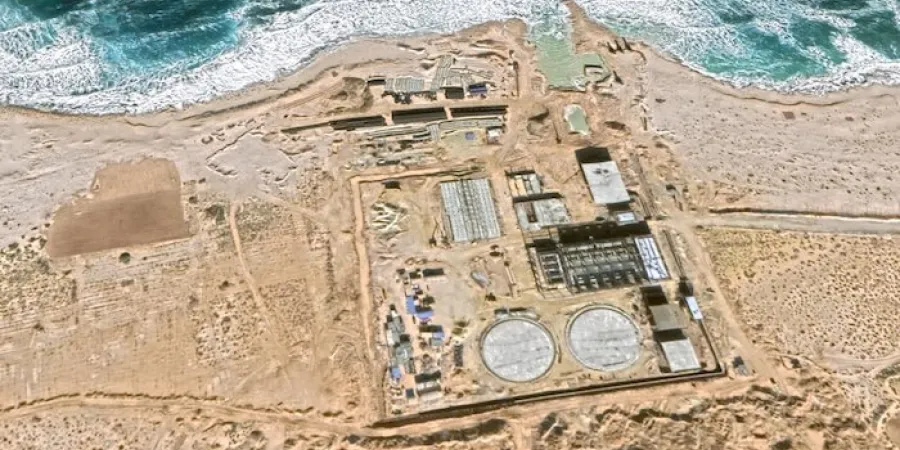Images Show Progress on El Dabaa Nuclear Power Plant
While the project has no direct implications for the development of nuclear weapons, it could legitimize future attempts by Egypt to build a uranium-enrichment or nuclear-fuel-reprocessing facility. For now, this is merely a theoretical concern
Ami Rojkes Dombe
|
24/04/2019
Satellite images published by Egyptian journalists show the progress made in the construction of Egypt’s El Dabaa Nuclear Power Plant. The plant, built by Russia’s Rosatom Corporation, will include four light-water reactors for electricity production.
Earlier this month, Egypt's Nuclear Power Plants Authority (NPPA) has received a site approval permit for the El Dabaa site from the Egyptian Nuclear Regulation and Radiological Authority (ENRRA). The permit acknowledges that the site and its specific conditions comply with national and international requirements, according to World Nuclear News.
Despite the nuclear context, the project has no direct implications for the development of nuclear weapons, according to an analysis by Lt. Col. (res.) Dr. Raphael Ofek published by the BESA Center. “It is, however, likely to legitimize any future attempt by Egypt to build a uranium-enrichment or nuclear-fuel-reprocessing facility. While Egypt has already gained significant experience in the nuclear field, neither its plans to develop a civilian nuclear power plant nor its efforts to develop nuclear weapons have yet borne fruit,” Ofek adds.
“The need for nuclear weapons returned to the agenda in Egypt and Saudi Arabia after the Iranian nuclear deal was struck in July 2015, though the Trump administration’s moves to stop Iran from nuclearizing have calmed the situation for now.
“As for the nuclear plant at El Dabaa, ten years will be needed to complete the project – a very long time in the Middle East. It is entirely possible that the project will meet the same fate as Egypt’s past efforts to build nuclear power plants. If the project is carried out, it will be impossible to use it directly for the development of nuclear weapons because of the need to use light-water reactors for ongoing electricity production and because the plutonium in these plants’ spent nuclear fuel will not be of nuclear weapons grade.
“In the long term, however, the existence of nuclear power plants in Egypt could give Cairo the legitimacy to build a uranium-enrichment plant at a low enrichment rate for the production of nuclear fuel for reactors. From there the path is short to a high rate of military-grade uranium enrichment. Operating power plants can also provide legitimacy for the building of a facility for reprocessing the plants’ spent nuclear fuel. If Egypt eventually builds a plutonium production reactor, it will have a new route towards developing nuclear weapons.”
While the project has no direct implications for the development of nuclear weapons, it could legitimize future attempts by Egypt to build a uranium-enrichment or nuclear-fuel-reprocessing facility. For now, this is merely a theoretical concern
Satellite images published by Egyptian journalists show the progress made in the construction of Egypt’s El Dabaa Nuclear Power Plant. The plant, built by Russia’s Rosatom Corporation, will include four light-water reactors for electricity production.
Earlier this month, Egypt's Nuclear Power Plants Authority (NPPA) has received a site approval permit for the El Dabaa site from the Egyptian Nuclear Regulation and Radiological Authority (ENRRA). The permit acknowledges that the site and its specific conditions comply with national and international requirements, according to World Nuclear News.
Despite the nuclear context, the project has no direct implications for the development of nuclear weapons, according to an analysis by Lt. Col. (res.) Dr. Raphael Ofek published by the BESA Center. “It is, however, likely to legitimize any future attempt by Egypt to build a uranium-enrichment or nuclear-fuel-reprocessing facility. While Egypt has already gained significant experience in the nuclear field, neither its plans to develop a civilian nuclear power plant nor its efforts to develop nuclear weapons have yet borne fruit,” Ofek adds.
“The need for nuclear weapons returned to the agenda in Egypt and Saudi Arabia after the Iranian nuclear deal was struck in July 2015, though the Trump administration’s moves to stop Iran from nuclearizing have calmed the situation for now.
“As for the nuclear plant at El Dabaa, ten years will be needed to complete the project – a very long time in the Middle East. It is entirely possible that the project will meet the same fate as Egypt’s past efforts to build nuclear power plants. If the project is carried out, it will be impossible to use it directly for the development of nuclear weapons because of the need to use light-water reactors for ongoing electricity production and because the plutonium in these plants’ spent nuclear fuel will not be of nuclear weapons grade.
“In the long term, however, the existence of nuclear power plants in Egypt could give Cairo the legitimacy to build a uranium-enrichment plant at a low enrichment rate for the production of nuclear fuel for reactors. From there the path is short to a high rate of military-grade uranium enrichment. Operating power plants can also provide legitimacy for the building of a facility for reprocessing the plants’ spent nuclear fuel. If Egypt eventually builds a plutonium production reactor, it will have a new route towards developing nuclear weapons.”



